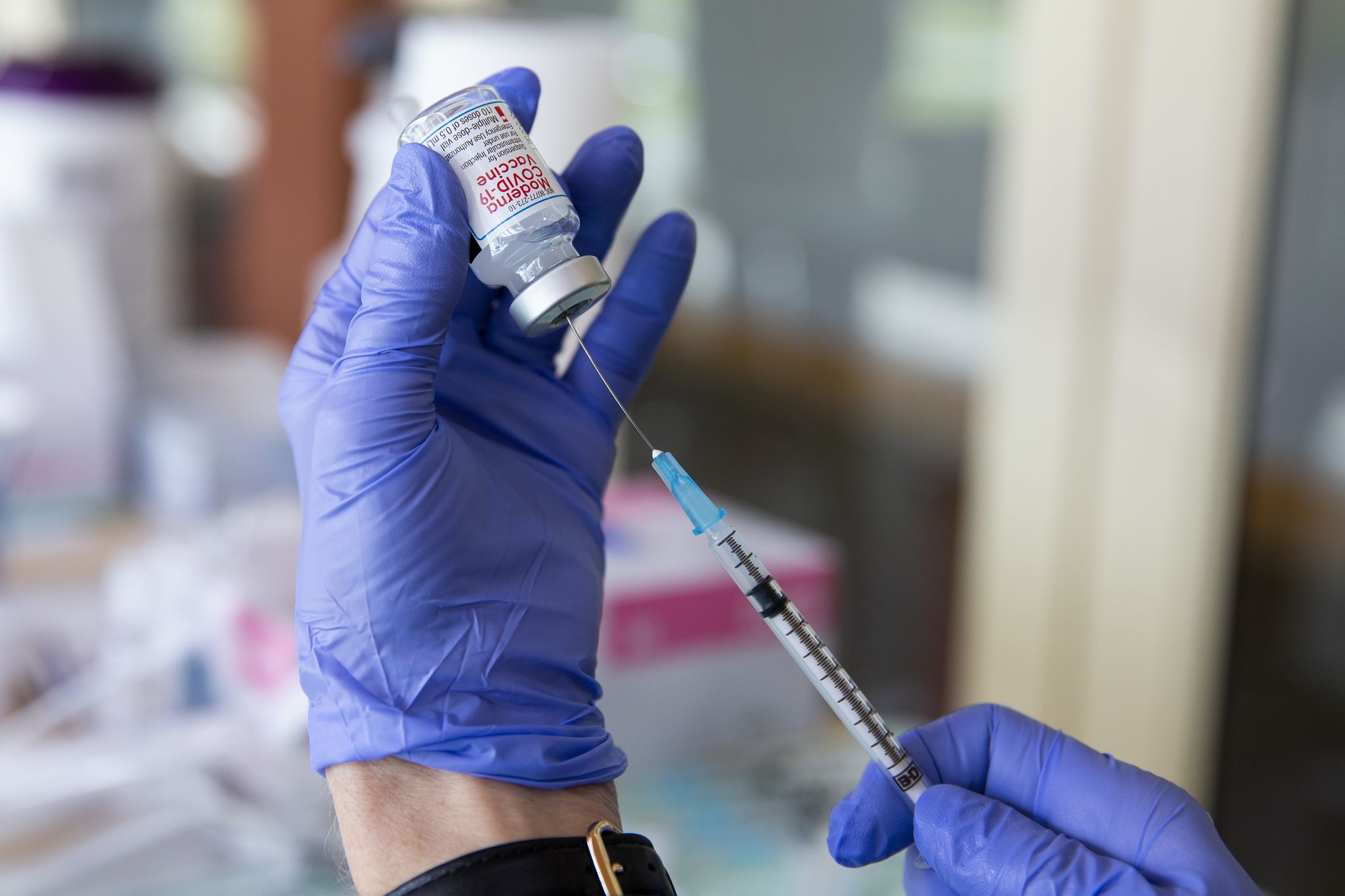A nurse draws up doses of the Moderna COVID-19 for a vaccination clinic in St. Helena in 2021. Moderna is offering a new, low-dose mRNA COVID vaccine this fall for people 65 and older and people 12 to 64 with an underlying medical condition that puts them at higher risk for severe COVID.
You may have seen ads for a new, lower-dose Moderna COVID vaccine marketed to “the senior class” — adults 65 and older.
The new vaccine, which goes by mRNA-1283 or mNexspike, was approved by the U.S. Food and Drug Administration in May, so this is the first fall respiratory virus season that it’s available for. It is approved for adults 65 and older and people 12 to 64 with an underlying medical condition that puts them at higher risk for severe COVID. The new Moderna vaccine is 10 micrograms, one-fifth the dose of the old Moderna vaccine (mRNA-1273 or Spikevax), which is 50 micrograms. Both are mRNA vaccines that target the LP.8.1 variant.
Overall, all three mRNA COVID shots — both Moderna products and the Pfizer vaccine — are roughly 40% to 60% effective at preventing COVID hospitalizations and deaths. But the new Moderna vaccine elicited slightly higher antibody responses in adults 65 and older compared to the old vaccine after one month, three months and six months, according to data that Moderna presented to the CDC’s Advisory Committee on Immunization Practices in April.
Article continues below this ad
The data was from the company’s Phase 3 clinical trial that included about 11,400 people 12 and older.
The new Moderna vaccine showed a 9.3% higher relative vaccine efficacy compared to the older Moderna vaccine in people 12 and older, and a 13.5% higher relative vaccine efficacy in people 65 and older, according to the trial data. Vaccine experts caution against assuming this means the new vaccine is “better,” as it’s based on preliminary data and in any case shows levels of protection comparable to the previous mRNA vaccines.
The new vaccine offers similar levels of protection as the older vaccine despite being a lower dose because of the way it’s designed. The old mRNA vaccines (both Moderna’s and Pfizer’s) target the entire spike protein, while the new Moderna vaccine targets two specific parts of the spike protein. These two parts are important because they are the regions that produce what appear to be the most protective antibodies.
“In other words, they only kept the parts of the protein that are most important for generating antibody responses, to focus the immune responses there,” said Nadia Roan, a UCSF professor and senior investigator at Gladstone Institutes who studies immunology.
Article continues below this ad
Dr. John Swartzberg, a clinical professor emeritus of infectious diseases at UC Berkeley, describes it as “a vaccine that’s more like a rifle than a shotgun. The rifle is aiming at the key targets.”
Because the new Moderna vaccine is a smaller dose, it may cause fewer side effects. The company’s clinical trial data showed that the rates of pain at the injection site (sore arm) were slightly lower compared to the old Moderna vaccine.
“Overall, there aren’t huge differences except a little less injection site pain,” Roan said. “I wouldn’t be surprised if the pain is a little less because you have less material.”
The rates of other side effects — such as fever, headache and fatigue — were about the same as the old Moderna vaccine.
Anecdotally, Swartzberg was curious about the new Moderna shot and got it for his fall COVID vaccine.
Article continues below this ad
“I’ve always had a really sore arm but not much else,” he said. “This time I hardly even had a sore arm.”
Overall, though, people shouldn’t be too worried about which COVID vaccine to get because they all provide protection, he said.
“I’d get what’s available. I don’t want anyone to read this and think, ‘Oh my god, I got the Pfizer or the more traditional mRNA vaccine, and I should’ve gotten the Nexspike,’” Swartzberg said. “They’ll get protection from all three of these.”
Someone might consider the new Moderna vaccine if the previous mRNA shots they got gave them a very sore arm, fever or other side effects that sidelined them for days afterward.
Article continues below this ad
“It’s up to the individual,” Roan said. “A reason to do it would be that it elicits a somewhat stronger antibody response, which could be good for the potency and durability from infection, although the clinical trial results suggested similar rates of protection. But some may also choose to stick with the familiar option if that’s what they’ve gotten before, since some may prefer to know what to expect in terms of side effects.”
The new Moderna vaccine may also be more stable and requires less extreme cold storage, which could give it an advantage in terms of transporting and storing it, Swartzberg said.
First Appeared on
Source link













